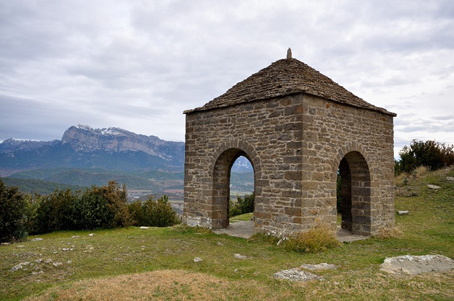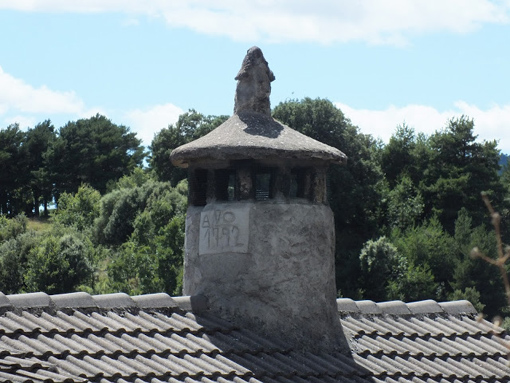Perhaps you do not know the word "Esconjuradero", a word that comes from the Aragonese --Aragón is a region of the Northeast of Spain-- : "Esconchurar", that means "to Conjure". Well, the “Esconjuraderos” are an architectonic element characteristic of the Culture and traditions from Pyrenees, with a strong presence in the Aragonese Pyrenees. The Esconjuraderos are small constructions or bandstands, that from the XVI to the XVIII century, were constructed specifically to house rituals, destined to hide or to conjure storms or thundering, hailstorm, the plagues and other dangers, that threatened to the harvests.

An Escoonjuradero
They are of simple and precise geometry, with sober and cold architecture, very few decorative elements and made with common materials (masonry, rough stone for bays and roofs, stone slab or Arabic tile). The walls can accommodate bays of different sizes, usually a half-point arch. The floor is unified with slabs of stone, brick or river stones, while the roof is made by a vault of cloister, a semi-spherical vault or false dome.
They represent an important proof and witness of the Pyrenean culture. The mountain society attended the aspects of climatology, with the same superstition and practices as in other aspects of everyday life. The Esconjuraderos constituted an important space, from which the priest and the population invoked to deflect or to undo the storms or thunders, that could spoil the fields and harvests. This is why these buildings are located at points, where there is a wide view of the horizon.

An Esconjuradero with a wide view of the horizon
Rituals, intended to ward (esconjurar) off storms and plagues, are classified within the beliefs and practices of a society, that firmly believed that magical-religious rituals; were the only weapon, that they had in order to control the devastating effect of nature on their lives. A rural society, with great difficulty in cultivation (water scarcity or land shortage, abrupt orography, technical difficulties, etc.) was highly sensitive, to cyclical natural phenomena, such as droughts, summer hailstorms or storms.
That is why it is not uncommon to observe that, in the traditional daily life of the Pyrenees, there existed a great number of rituals, related to the protection of houses, people, fields, animals ... --such as scarecrows in “Chamineras”, ie “traditional chimneys”-- or thistles and feet of animals, on the doors of houses).

A "Chaminera" with scarewitch. You can read: Year 1792
Like so many other traditions of pagan origin, this attempt to control the nature, that the human being made from ancestral times, was Christianized by the Church, becoming part of the Catholic liturgy. In this context, the rituals to hide are classified. According to some authors, since the beginning of the sixteenth century, spells, made in the porticos, windows or church steeples, are documented. The references to these rituals dot the province of Huesca and it does not seem strange that different shrines, specifically designed for that purpose, were created.
While the priority mission of these rituals was probably to ward off storms or thunderstorms and to protect the fields from the devastating effects of lightning and hailstones, their mission is also documented as a repeller of pests and damaging animals. In addition, in the Middle Ages, there was a widespread belief, that there were people with special powers, capable of performing enchantments, that caused storms and hurricanes. In fact, the Church admitted that there could be human beings, such as prophets, who with their prayers could get rain or cause fire or hail to fall. It also permitted the carrying out of masses to obtain rain or to conjure natural calamities. That is to say, there was a common belief that certain people could manipulate the forces of nature, in a positive sense for the human being, or against it. It is therefore understood that, in many cases, the neighbors thought that the storm, that had ruined their crops, had been originated by the arts of some witch or other magical agent.
Well, I hope that you have liked this article.
Until my next post, kind regards,
Luis.
Sponsored by Costaluz Lawyers.
Please click below:
